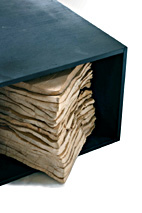






|
|

Armanda Verdirame, nata a Novara, si è formata nell’ambiente artistico milanese, lavorando con archithetti e sperimentando in parallelo tutte le tecniche espressive - dall’acquaforte alla ceramica. Le esperienze di insegnamento hanno inizialmente contribuito a un percorso di ricerca da sempre documentato, dagli Anni ’70 in poi, con mostre personali e collettive.
La parola al critico
Stratificazioni di segni - Armanda Verdirame inizia la sua ricerca artistica riferendosi a quella temperie culturale animata da Giuseppe Spagnulo, Nanni Valentini, Luigi Mainolfi impegnati a “rifondare” la scultura attraverso il recupero della dimensione artigianale, utilizzando la terra e caricandola di simbologie ancestrali, riconducendola alla memoria culturale. Anche la Verdirame manipola la terra in forma di continua allusione geomorfica, insieme mitica e metamorfica. Come in Nanni Valentini, per Armanda Verdirame la materia è identificata con la terra, in tutte le sue forme e possibilità interpretative. Se usa il bronzo o il ferro è solo per considerarla da un altro punto di vista.
La terra è vista come un partner che risponde all’artista con segni suoi. Le esperienze concettuali, calligrafiche in particolare, suggeriscono ad Armanda di esprimere la sua riflessione sui miti legati alla terra, scegliendo il seme come segno a partire dal quale elaborare un alfabeto da apporre alle sue sculture. Spesso questi alfabeti sono nascosti nella terra come fossili della comunicazione, persistendo tra le stratificazioni del tempo. Questo è il centro dell’indagine della Verdirame: la “stratificazione” di simboli, linguaggi, segni, anche comportamentali. Molto spesso sono fogli di terra, sovrapposti gli uni agli altri, spesso racchiusi in scatole, che diventano dimensioni spazio temporali a sé stanti ma che nella loro finitezza ne presuppongono altre, moltitudini di dimensioni parallele che anelano ad un centro, ad un’energia cosmica che a sua volta le attrae tutte. (Marco Tagliaferro)
Le mostre più recenti/The most recent exhibitions
Semicosmi (personale, 1996, Società umanitaria); Il filo e il seme (personale, 1997, Credito Bergamasco); Preparala al chip (personale-dalla, 1998, Galleria Ragno); Libro contenitore CD d’oro (Sony, Roma, Città del Vaticano Abbà Pater); Semiritmica (installazione, 2001, Galleria Scoglio di Quarto, MI); Golfo Mistico ((installazione, 2001, Auditorium Verdi, MI); Le opere e i giorni (personale, 2002, Galleria San Carlo, MI); Alla ricerca della luna (personale, 2002, Salsomaggiore, PR); VI Grafichki (2004, Uzice Suva Igla Bijenale); Semibacter: dire, fare, capire la scienza (2004, Museo della Scienza, MI); Monocromo (2005, Galleria Francis van Hoof Puurs, Anversa, Belgio).
Armanda Verdirame, born in Novara, spent her formative period in Milanese artistic circles, working with architects while at the same time experimenting with all the expressive techniques - from etching to ceramics. This led to a process under which her work developed, documented from the seventies onwards with one-man and collective shows.
A word from the critic
Stratification of signs - Armanda Verdirame commenced her artistic experience imbibing the cultural atmosphere created by Giuseppe Spagnulo, Nanni Valentini, Luigi Mainolfi in their wish to “refound” sculpture by a return to a craftsmanlike approach, using earth and imbuing it with ancestral symbolism, referring to a cultural heritage. Verdirame also works earth in forms that have continuous geomorphic as well as mythical and metamorphic allusions. As with Nanni Valentini, for Armanda Verdirame material is identified with earth in all its forms and interpretative possibilities. If she uses bronze or iron it is only to consider earth from another point of view. It is seen as a partner that responds to the artist with its own signs.
The conceptual and calligraphical experiences in particular have induced Armanda to express her reflections on the myths associated with the earth, choosing the seed as a sign from which to devise an alphabet to be cast onto her sculptures.
Often these alphabets are hidden in the earth like fossils of communication, persisting amidst the stratifications of time. This is what Verdirame’s work centres on: the “stratification” of symbols, languages, signs, even behavioural ones. Very often these are sheets of earth, laid on top of each other, multitudes of parallel dimensions that yearn for a centre, a cosmic energy that in turn attracts them all.
(Marco Tagliaferro)
|
|

Libro di sedimentazione
1998, terracotta e legno, cm 26x26x19
|